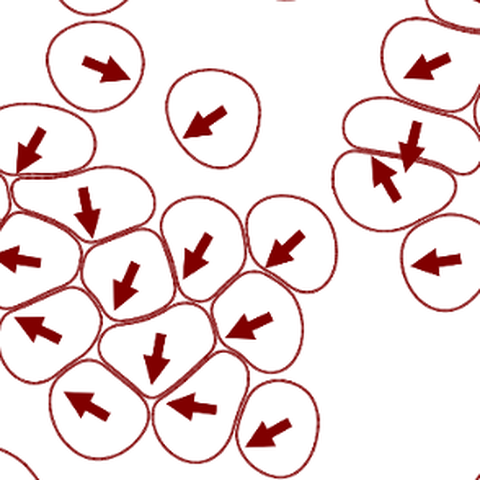Interacting cells

Interacting deformable objects, simulated on a highly parallel multi-core system.
The geometry of cells is often described only in terms of the shape of the cell membrane. It is assumed to deform based on a simple Helfrich model that includes bending stiffness and curvature terms. An even more simplified model, which better describes the shape of fluid droplets, is based on a conserved mean curvature flow. The model becomes more involved when considering not just one cell, but hundreds or thousands of cells whose shapes are separated from each other and interact with some interaction potential parameterized by the distance between the cells.
Research focus
We have formulated a model for the (steric) interaction of many cells (membranes) based on a phase field description for each cell. This leads to a large system of Cahn-Hilliard equations to be solved. Due to loose coupling, i.e. interaction only between neighboring cells, the whole system can be parallelized using OpenMP or an MPI communication approach.
Student projects and thesis topics
- Master thesis: "Data exchange between independently refined grids and its application in multi-phase-field-models" (F. Ross, 2022)
- Parallelization of a model for cell migration coupled to a Navier-Stokes equation (Collective cell migration with hydrodynamic interactions)
- Hybrid parallelization (e.g. OpenMP + MPI) for a cell-interaction model
- Development of a Multi-Mesh approach for Dune.
Interaction with other researchers
- Lea Happel, M.Sc.
- Jan Sischka, M.Sc.
- Dr. Dennis Wenzel
Publications
- L. Happel, H. Hardering, S. Praetorius, A. Voigt. Surface Minkowski tensors to characterize shapes on curved surfaces. 2025, [arxiv]
- H. Garcke, R. Nürnberg, S. Praetorius and G. Zhang. Isoparametric finite element methods for mean curvature flow and surface diffusion. Journal of Computational Physics, 539, October 2025, 114248, [doi], [arxiv]
- D. Wenzel, S. Praetorius and A. Voigt, Topological and geometrical quantities in active cellular structures, The Journal of chemical physics. 150(16):164108, April 2019, [doi]
- S. Praetorius and A. Voigt, Collective cell behavior - a cell-based parallelization approach for a phase field active polar gel model, In Proceedings of the 9th NIC Symposium, 2017. [link] [bibtex]
- F. Alaimo, S. Praetorius, and A. Voigt, A microscopic field theoretical approach for active systems, In New J. Phys., Vol. 18 (8), pp. 083008, 2016. [doi] [bibtex]
- W. Marth, S. Praetorius, and A. Voigt, A mechanism for cell motility by active polar gels, In J. R. Soc. Interface, Vol. 12 (107), 2015. [doi] [bibtex]
